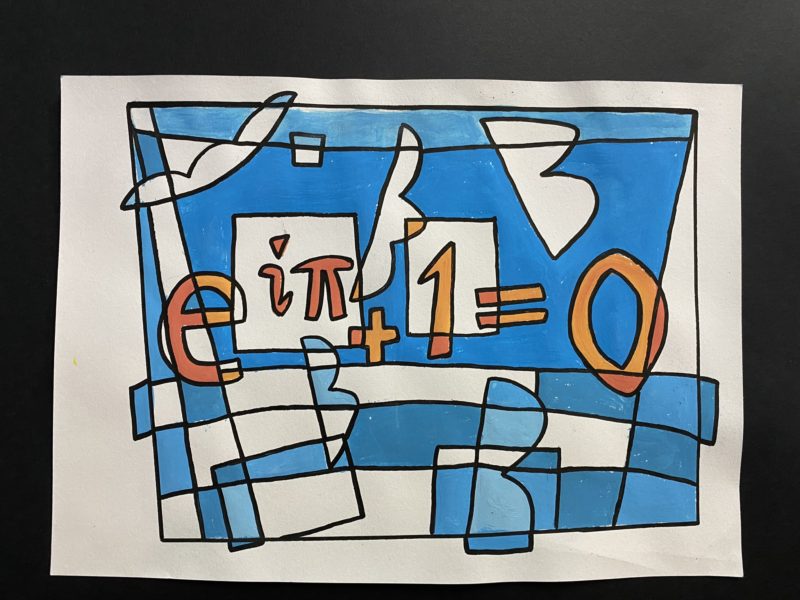We have all experienced our awkward moments. Something unexpected happens, there is some social tense and a personal uneasiness and you would really like to get over it or forget that it ever happened. But what if you are a rigorous mathematician and you just got your world disproven?
Math has always been about the pursuit of understanding the world through logic and expressing it in a strictly defined, mathematical language. It is really indicative, educative, and fun, to observe mathematics when it stopped (momentarily) making sense.
1. The discovery of irrational numbers
As the origins of mathematical rigor lie in ancient Greece, mathematical thought started close to religious beliefs, thus numbers were attributed divine characteristics.
The School of Pythagoras, an occult team of early mathematicians that pushed mathematical knowledge forward, like all cults, was based on some fundamentalistic beliefs. Astonished by the applicability of ratios to every practical problem, they believed that ratios (yes, simple divided numbers) are divine, as they can explain anything that is happening in the world.
Accordingly, everything that is happening in the world should be able to be expressed as a ratio, right?
Now, imagine their surprise when they discovered the number square root of 2, while applying the newly formulated Pythagorean Theorem. This irrational number (irrational meaning that it cannot be expressed as the ratio of two numbers) defied world order as expressed by divinity of ratios and questioned their whole philosophy.
Terrified by the consequences of this revolutionary discovery, they decided not to tell anyone about it. It is also said, that they even drowned the man who did the discovery, Hippasus. Quiet scientific, don’t you think?
2. Infinity
The discovery of irrational numbers, being already bad as it was, brought the Greeks in front of a more terrifying discovery: infinity. As irrational numbers are characterized by having an infinite number of decimal digits, Greeks had to come up with an explanation for how a never-ending series of numbers can be created. The notion of infinity is difficult to understand today, let alone an age when religion was connected with science and a mathematical belief should not challenge our understanding of God. So, what did the Greeks do? Philosophers, like Aristotle and Plato, rejected the notion of an absolut infinity and mathematicians came up with inventive ways to circumvent the need for infinity in geometry, like Eudoxus of Cnidus who developed the method of exhaustion to calculate the area of shapes. It was not until the late 17th century that Newton and Leibniz encouraged taking infinity into account through their use of infinitesimals and John Wallis introduced the well-known symbol of infinity in 1655.
3. Zeno’s paradoxes
The Greeks certainly went to extremes when it came to philosophical reasoning.
After his predecessor Heraclitus claimed that everything in the world is constantly changing, Parmenides claimed that nothing changes. As a result, motion is a mere illusion and therefore, using mathematics, the language of truth according to the Greeks, to describe it should be impossible.
Zeno, one of Parmenides’ students, devised a series of paradoxes aimed to prove the irrationality of motion. The most famous one, Achilles and his tortoise, goes like this: Achilles is racing against a tortoise, which being significantly slower is given the advantage of starting the race 100 meters ahead of him.
If we assume, for the shake of simplicity, that the speeds of the two contestants are constant and Achilles is 10 times faster than the tortoise then we can say that when Achilles reaches the starting point of the tortoise, this will have run 10 meters. So, Achilles will try to catch up and by the time he reaches this next point, the tortoise will have moved an extra one meter.
This high-school math problem, being as simple and clear as it is, leads us to the following paradoxical conclusion: Achilles will never reach the tortoise no matter how much faster he is. Congratulations Zeno, you made motion sound illogical.
Zeno’s paradoxes were believed to exist in the realm of metaphysics and troubled philosophers and mathematicians for ages, but today they can be explained with calculus, a mathematical tool the Greeks did not possess. Let’s “move” on then.
4. Möbius strip

A make-it-yourself Möbius strip
The funny looking Möbius strip, which was also independently discovered in 1858 by the unlucky Listing whose name left the history of mathematics untouched, is a surface with only one side and only one boundary, often used to puzzle young math students.
You can easily create it by taking a strip of paper, twisting it and then joining the ends of the strip.
Being the first example of a surface without orientation it did not shake the grounds of mathematics as much as the other discoveries of this list did, yet it provided a lot of practical applications, such as a resistant belt, and inspired mathematicians to come up with unorientable surfaces, like the Klein bottle. (The name of this surface possibly comes from a double coincidence: Klein, its conceptor, originally named it Fläche, which means surface in German and sounds similar to Flasche, which means bottle. The fact that it also looked like a bottle seems to have sealed the renaming).
5. Cantor’s uncountability of real numbers
Dealing with infinity already being a drag, Cantor proved in 1874 that there are in fact different kinds of infinity. In particular, proving the uncountability of real numbers, Cantor proved that this set is bigger to the already infinite set of natural numbers.
In 1891, he also provided the diagonal argument, one proof so elegant that it was later adopted as a tool to prove through the use of a paradox. His remark gave birth to the theory of cardinal numbers, as well as paradoxes dealing with the question: how many infinities can you handle?
6. Russell’s paradox

Bertrand Russell was a mathematician, philosopher, logician, mathematician, historian, writer, social critic, political activist and, to my opinion, a personality worth studying and inspiring oneself from.
In 1901 Russell discovered a weak spot in Cantor’s so-far well-established set theory, which led him to a contradiction the mathematical world could not oversee. According to this theory, any collection of things can be a set.
Russell’s contradictory example, also called the Barber’s paradox, goes as follows: imagine a town that has a special rule; every man that is not shaved by himself must be shaved by the barber of the town. The awkward question, which you can try to answer yourselves, is: who shaves the barber?
This discovery led him to questioning the mere foundations of the previous set theory and creating a new one, which being more complicated than the later proposed Zermelo-Fraenkel set theory, did not catch up.
7. Gödel’s incompleteness theorems

Kurt Gödel the logician, mathematician and philosopher that shook the grounds of mathematics and logic in the 19th century.
If the previous events seemed to create slightly uncomfortable moments, wait for the following awkward turtle (and this is worse than the one of Achilles).
We are talking about the 20th century. People did not just want to know. They wanted to know if it is possible to know, and prove it. Unluckily for them, and the human need for understanding the universe, Gödel published in 1931 two theorems, known as the incompleteness theorems.
Explaining the technicalities of them is as difficult as coming in terms with their conclusions, as what Gödel proved was that, considering a consistent and complete system, such as the language of arithmetic, there are statements that are both true and cannot be proven. He illustrated the truth of his theorem with this simple statement, inspired by the liar’s paradox: “This statement cannot be proven”. If this is true, then this statement is true and cannot be proven. If this is false, then this statement can be proven, which contradicts to the original argument that it cannot be proven.
These were very bad news for mathematics, depriving them of their original glare of explaining the absolute truth. It was also a terrible comeback to Hilbert’s quest for knowledge, expressed in his statement “We must know, we will know”.
8. Tarski’s undefinability theorem
It seems that Tarski was inspired by the despair created by Gödel. In 1936 he provided proof for the undefinability problem.
Although the observations made by Tarski are also included in Gödel’s work, it is argued that Tarski’s work has a more profound philosophical impact. Tarski managed to reach the general conclusion that a language cannot define truth in itself. Although this is an important limitation, he suggests that using a more powerful meta-language is sufficient to define truth in the simpler language.
Now, an ordinary person may think that this solves the problem, but for a mathematician looking for the “one language to rule them all” this is not that consoling.
9. The halting problem
Alan Turing attempted to tackle the decision problem, which, in simple words, dealt with finding an algorithm that can answer whether a statement is true or not. In order to tackle this conceptually simple, but hard-to-solve problem, he rephrased it to the halting problem: is there a machine that can tell you whether a program will halt on a given problem?
Halting means that it will not loop forever. But how do you prove the infeasibility of a machine you know so little about? This is where paradoxes come handy.
Alan Turing began by assuming the existence of a machine which given an input program and a problem answers the question of whether it will halt or not. He then augmented this machine by looping its output back to itself if the answer was yes and halting if the answer was no.
So, will the augmented machine halt on the halting problem? Alan’s answer is: if yes then no, if no then yes. Sounds like bad news for logic.
10. The No Free Lunch Theorem
The passage to the 21st century signified a transfer from pure, almost philosophical mathematics, to applied areas, such as statistics and optimization.
If you consider yourself being fond of optimization, don’t you think this will make you a perfectionist? And wouldn’t a perfectionist want to find the optimal way to optimize things?
It seems that David Wolpert and William Macready sensed this need and came up with an answer, which, of course, was not encouraging at all (otherwise it would not be in our list). According to their No free lunch theorem for Optimization, published in 1997, “any two optimization algorithms are equivalent when their performance is averaged across all possible problems.”
Heart-breaking this may be, it does not mean optimization is futile. We’ll just never find a generally optimal way to do it.
These moments made the world of mathematics feel awkward, which is a light term for the feelings of despair and chaos that scientists tend to experience when the universe stops making sense. But shock is the way to move science forward.
Mathematical fields were created, we got the Turing Machine, fancy looking surfaces and, most importantly, the ability to re-examine our perceptions and adapt our tools accordingly.
These questioning moments helped us evolve intellectually.
Except for the incompleteness theorems. These were just devastating.


